U.S. ARMY BOGS DOWN IN HUERTGEN FOREST
Huertgen, Germany • November 16, 1944
On September 19, 1944, elements of Lt. Gen. Courtney Hodges’ First U.S. Army entered the 10‑mile/16‑kilometer-wide, 20‑mile/16‑kilometer-long Huertgen Forest (Hürtgenwald) southeast of Aachen. The ancient capital of Holy Roman emperor Charlemagne and a northern node on Germany’s “dragons’ teeth” defensive Westwall (known to the Allies as the 390‑mile/628‑kilometer-long Siegfried Line), Aachen was the first major city inside Germany targeted for capture by the Western Allies. It eventually fell on October 21, 1944. From Aachen Hodges’ First Army made for the Huertgen Forest, which lay less than 10 miles/16 kilometers away and stood in the First Army’s path to a Rhine River crossing south of the large cathedral city of Cologne. Tragically, it was in the thick, hilly forest that GIs experienced some of the fiercest close-combat fighting of the entire European War. Indeed, the battle to push through the Huertgen Forest to the Rhine was the longest fought on German soil during World War II and was the longest single battle ever fought by the U.S. Army.
Initially, the goal of U.S. Army commanders was to pin down German forces in the area to keep them from reinforcing their front lines further north during the Battle of Aachen. In a second phase the army wanted to advance to the Roer (Rur) River, which flows from Belgium into Germany and on to the Netherlands. Of course, beyond the Roer was Hodge’s real objective, a bridgehead on the Rhine’s east bank. However, little did American commanders know that the reason for the desperate German defense in the Huertgen Forest was to prevent a breakthrough just north of their staging area for the forthcoming Ardennes Offensive, better known to the Allies as the Battle of the Bulge (December 16, 1944, to January 25, 1945).
On this date, November 16, 1944, Hodges moved the men and equipment of his First Army through the dense evergreen Huertgen Forest toward the banks of the Roer River. Overhead, U.S. and British warplanes flew in the war’s largest air support of ground troops. Unfortunately, Hodges’ grinding assault to reach the Rhine failed even to secure the Roer, dammed at 2 strategic locations. The dams (lower right corner in map below) were eventually secured in February 1945 after the Germans had destroyed the dams’ outflow control apparatus, flooding the Roer, and thereby delaying the Americans’ final push to the Rhine by a critical 2 weeks.
The casualty rate for every forested meter taken was mind-boggling and a needless tragedy. The First Army lost 25,000 out of nearly 100,000 men fighting in and near the forest. One infantry division lost 3 commanders in a single day. A rifle company suffered more than 500 percent casualties after replacements were factored in. The short tenure of new company and platoon leaders meant that some men never learned their leaders’ names. Local foresters provided German units with much of their intelligence, which gave the understrength enemy an advantage denied to the intruders. Felled trees blocked forest trails, which often were mined, booby-trapped, and led nowhere. The ridges above the forest tree line afforded the enemy good places to mount artillery and monitor activity at lower elevations. Although it limited visibility, the tangled forest provided enemy snipers a safe venue from which to operate. American officers tucked their field glasses inside their shirts to avoid being targeted. In other areas the Germans trimmed the lower branches of trees to provide better fields of fire for their machine guns.
In villages such as Huertgen, which was taken on November 28, fighting was often hand to hand and house to house, with GIs using rifles, machine guns, and grenades thrown through doors and windows. So chaotic and brutal was combat in the Huertgen Forest that many German officers said it exceeded that on the Eastern Front. In early December, with Hodges’ men finally out of the forest yet exhausted by a remarkably resilient enemy in the reckless first phase of fighting, the Wehrmacht (German armed forces) prepared its Ardennes Offensive.
U.S. Thrust Into Huertgen Forest Bogs Down, Turns Hellish
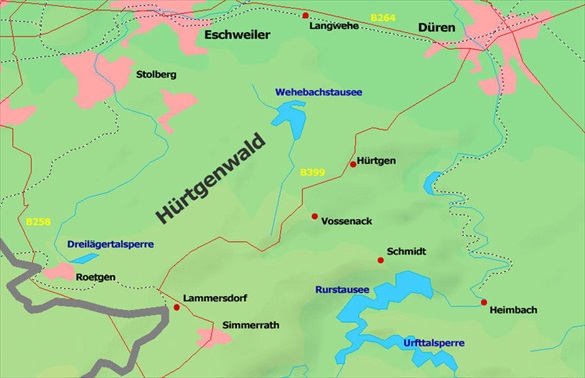 |
Above: Map of the Huertgen Forest (Hürtgenwald) and surrounding villages. From September 19, 1944, to February 10, 1945, U.S. and German forces fought each other in the thickly wooded Huertgen Forest. The terrain was a 50‑sq.-mile/129.5‑sq.‑km expanse of tall, dense pinewoods rising from steep rocky crags and treeless ridges laced by plunging valleys and deep winding ravines and streams east of the Belgian border in today’s German state of North Rhine-Westphalia. Much too late did the abrasive, conceited, often ill Hodges and his over-confident First Army headquarters truly appreciate the challenges First Army soldiers faced fighting in a foreboding and disorienting environment like the Huertgen Forest. The prolonged forest-clearing campaign cost Hodges’ army at least 33,000 killed and wounded out of 120,000 men deployed. The 33,000 figure includes 9,000 friendly-fire and noncombat casualties among men suffering from hypothermia, frostbite, pneumonia, trench foot (aka immersion foot), self-inflicted wounds, and combat exhaustion (8,000 cases of “psychological collapse”). The Germans suffered 28,000 combat and noncombat losses, of which 12,000 were fatalities. Many were killed by U.S. artillery or fighter-bombers before they reached the front lines. Mortar rounds caused the greatest proportion of battle casualties on both sides.
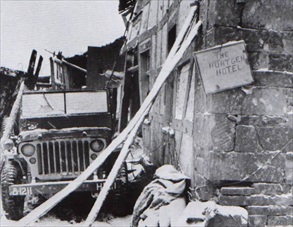 | 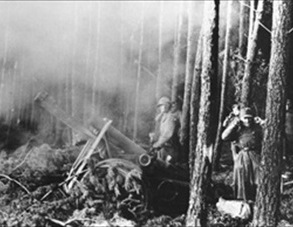 |
Left: This destroyed farmhouse on the main route through the Huertgen Forest served as shelter for a regimental command post. The men of Maj. Gen. William G. Weaver’s 8th Infantry Division, 121st Infantry Regiment nicknamed the farmhouse the “Hürtgen Hotel” (see faded sign on wall). Photo taken January 8, 1945.
![]()
Right: A German 155 mm heavy mortar crew firing in defense against a U.S. attack on November 22, 1944, in the Huertgen Forest. German defenders fired mortars and artillery from positions whose ranges had been calculated in advance. Germans also used their 88 mm guns to fire at Allied bombers en route to Rhineland cities or to fire directly at Allied tanks or through forest treetops. Though American firepower was greater (8 inch and 240 mm), it was initially limited by an ammunition shortage (fewer than 4 rounds per day). Both sides used their artillery to smash and shred the closely bunched trees, some as tall as telephone poles whose splinters, along with red-hot shell fragments, smashed down on men and inflicted heavy casualties on anyone caught in the open.
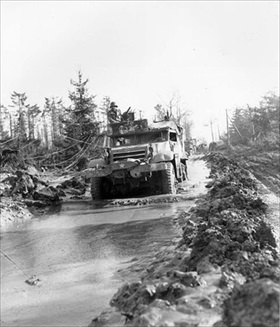 | 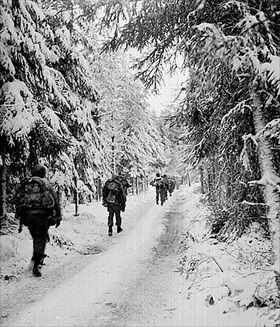 |
Left: A 1st Infantry Division half-track negotiates a muddy road in the Huertgen Forest. Rain turned forest roads into muddy rivers, making it nearly impossible for wheeled vehicles to get traction. Roads, tracks, and firebreaks were often mined, sometimes 3 mines deep. Each platoon of light tanks required a squad of infantry and another squad of engineers to perform mine removal. Both sides booby-trapped the narrow paths and forward positions by laying trip-wires hidden in the churned-up earth or snow. For Americans at this stage in the war in Europe, forest fighting was learned on the job, a risky business when combined with shortages of ammunition, seasoned veterans, and good weather. Photo from February 15, 1945.
![]()
Right: Men of the 517th Parachute Regimental Combat Team trudge along a snowy track through the Huertgen Forest on a misty day in early February 1945. The men must have been confident that the enemy had evacuated the area or at least had not zeroed in their mortars on this track, a technique Germans commonly employed in the otherwise impenetrable forest. The 517th RCT fought engagements in the Ardennes Forest (December 16, 1944, to January 25, 1945) followed on February 3, 1945, by engagements in the Huertgen Forest, where it was mostly attached to the new 78th Infantry “Lightning” Division in Hodges’ U.S. First Army.
Battle of Huertgen Forest: Unrelenting Bloodbath in Woods Southeast of Aachen
![]()

 History buffs, there is good news! The Daily Chronicles of World War II is now available as an ebook for $4.99 on Amazon.com. Containing a year’s worth of dated entries from this website, the ebook brings the story of this tumultuous era to life in a compelling, authoritative, and succinct manner. Featuring inventive navigation aids, the ebook enables readers to instantly move forward or backward by month and date to different dated entries. Simple and elegant! Click
History buffs, there is good news! The Daily Chronicles of World War II is now available as an ebook for $4.99 on Amazon.com. Containing a year’s worth of dated entries from this website, the ebook brings the story of this tumultuous era to life in a compelling, authoritative, and succinct manner. Featuring inventive navigation aids, the ebook enables readers to instantly move forward or backward by month and date to different dated entries. Simple and elegant! Click 











